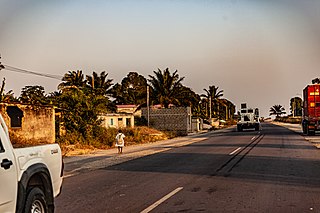Related Research Articles

The Kingdom of Kongo was a kingdom in Central Africa. It was located in present-day northern Angola, the western portion of the Democratic Republic of the Congo, Southern of Gabon and the Republic of the Congo. At its greatest extent it reached from the Atlantic Ocean in the west to the Kwango River in the east, and from the Congo River in the north to the Kwanza River in the south. The kingdom consisted of several core provinces ruled by the Manikongo, the Portuguese version of the Kongo title Mwene Kongo, meaning "lord or ruler of the Kongo kingdom", but its sphere of influence extended to neighboring kingdoms, such as Ngoyo, Kakongo, Loango, Ndongo, and Matamba, the latter two located in what is Angola today.

Soyo is a city, with a population of 200,920, and a municipality, with a population of 227,175, located in the province of Zaire in Angola, at the mouth of the Congo river. Historically, Soyo was a significant city in conflicts between the Kingdom of Kongo, Portuguese Angola, and the Dutch West India Company. Soyo became an independent state in the 17th century and had significant influence on politics in Kongo during the Kongo Civil War.

The Kimpanzu were members of the Mpanzu kanda also known as the House of Kimpanzu, one of the lineages from which the kings of Kongo were chosen during the 17th century and following Kongo's reunification under Pedro IV. They are remembered in tradition and are evoked in a proverb, still current in the 1920s Nkutama a mvila za makanda "Kinlaza, Kimpanzu ye Kinlaza makukwa matatu malambila Kongo".

The Kinlaza were members of the Nlaza kanda or House of Kinlaza, one of the ruling houses of the Kingdom of Kongo during the 17th century. It was one of the main factions during the Kongo Civil War along with the Kimpanzu and Kinkanga a Mvika kandas. They are remembered in tradition and are evoked in a proverb, still current in the 1920s Nkutama a mvila za makanda "Kinkanga, Kimpanzu ye Kinlaza makukwa matatu malambila Kongo".
The Battle of Kitombo was a military engagement between forces of the BaKongo state of Soyo, formerly a province of the Kingdom of Kongo, and the Portuguese colony of Angola on 18 October 1670. Earlier in the year a Portuguese expeditionary force had invaded Soyo with the intention of ending its independent existence. The Soyo were supported by the Kingdom of Ngoyo, which provided men and equipment, and by the Dutch, who provide guns, light cannon and ammunition. The combined Soyo-Ngoyo force was led by Estêvão Da Silva, and the Portuguese by João Soares de Almeida. Both commanders were killed in the battle, which resulted in a decisive victory for Soyo. Few, if any, of the invaders escaped death or capture.
Afonso II of Kongo and Nkondo was a ruler of the kingdom of Kongo in the period following the Kongo Civil War. He was a member of the House of Kimpanzu and may have been supported in his claim for the throne by partisans in Soyo. He took the throne in November 1665 in the first of a series of power grabs for the throne of the kingdom.
The Kongo Civil War (1665–1709) was a war of succession between rival houses of the Kingdom of Kongo. The war waged throughout the middle of the 17th and 18th centuries pitting partisans of the House of Kinlaza against the House of Kimpanzu. Numerous other factions entered the fray claiming descent from one or both of the main parties such as the Água Rosada of Kibangu and the da Silva of Soyo. By the end of the war, Kongo's vaunted capital had been destroyed and many Bakongo were sold into the Trans-Atlantic Slave Trade.
The Battle of Mbidizi River was a military engagement in June 1670 between forces of the County of Soyo and those of the Portuguese colony of Angola during the Kongo Civil War. The engagement was part of a military campaign to break the power of Soyo in the region. The Portuguese won a decisive victory, inflicting heavy casualties and killing the Soyon leader.

The Kinkanga, usually known as the Kinkanga a Mvika or House of Nsundi, was a royal kanda formed by King Pedro II, which ruled the Kingdom of Kongo from 1622 to 1631. While King Pedro II and his son Garcia I were the only other member of the faction or kanda to rule, it retained powerful members in provincial offices in the 1650s until its destruction in the 1670s. Despite this loss in prominence, they were remembered in tradition and are evoked in a proverb, still current in the 1920s Nkutama a mvila za makanda "Kinlaza, Kimpanzu ye Kinlaza makukwa matatu malambila Kongo".
Alvaro VIII, of the House of Kinlaza, was king of the Kingdom of Congo, from 1666 to 1669.

Pedro IV Nusamu a Mvemba. King of Kongo, ruled from 1695 to 1718, although his effective reign of Kongo was only from 1709. He is noted for restoring the country and ending the civil war that had raged since 1666. The career of Beatriz Kimpa Vita, the prophetess claimed to be possessed by Saint Anthony, took place during his reign.
Álvaro IX Mpanzu a Ntivila was a ruler of the Kingdom of Kongo during its civil war period. He ruled from June 1669 to 1670.
Rafael I Nzinga a Nkanga was a ruler of the Kingdom of Kongo during its civil war. He ruled from 1670 to 1673.
Daniel I Miala mia Nzimbwila was a ruler of the Kingdom of Kongo during its civil war between the various royal houses. He ruled from 1674 to 1678.
Garcia III Nkanga a Mvemba was a ruler of Kibangu and was one of the two main Kinlaza claimants to the throne of the Kingdom of Kongo during its civil war, the other being the King of Lemba. He ruled the Kingdom of Kibangu from 1669 to 1685.
Manuel Afonso Nzinga a Nlenke was a ruler of Kibangu and was one of the two main Kinlaza claimants to the throne of the Kingdom of Kongo during its civil war, the other being the King of Lemba. He ruled the Kingdom of Kibangu from 1685 to 1688.
João II Nzuzi a Ntamba was a ruler of Lemba and was one of the main Kinlaza claimants to the throne of the Kingdom of Kongo during its civil war, the other being the King of Kibangu. He ruled the Kingdom of Lemba from 1680 to 1716.
Manuel II or Manuel II Mpanzu a Nimi (???-1743) was ruler of the Kingdom of Kongo (1718–1743). He ruled in a period of "rotating lineages" as planned by his predecessor and was of the Kimpanzu. He had once fought against Pedro during the recapture of São Salvador.
Ana Afonso de Leão was the queen regnant of the Kingdom of Nkondo between 1673 and 1710. She conquered the territories of Lemba and Matari, as well as those located along the Mbidizi river in the Kingdom of Kongo in the 17th century. She was a decisive figure during the Kongolese civil war.